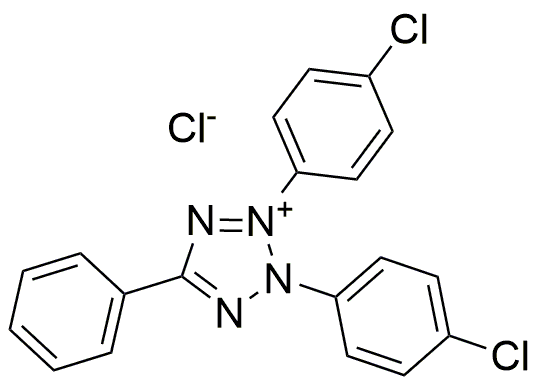2,3-Bis(4-chlorophenyl)-5-phenyltetrazolium chloride is widely utilized in research focused on:
- Cell Viability Assays: This compound is commonly used in laboratory settings to assess cell viability and proliferation. It can help researchers determine the effects of various treatments on cell health.
- Biochemical Research: It serves as a vital reagent in studies related to enzyme activity and metabolic processes, allowing scientists to explore cellular functions in detail.
- Pharmaceutical Development: The compound plays a role in drug testing, particularly in evaluating the efficacy of new pharmaceuticals against specific cell lines, aiding in the development of effective therapies.
- Environmental Toxicology: Researchers utilize it to assess the toxicity of environmental samples, helping to evaluate the impact of pollutants on living organisms.
- Diagnostic Applications: It is also used in various diagnostic assays, providing a reliable method for detecting specific biological markers in clinical samples.
General Information
Properties
Safety and Regulations
Applications
2,3-Bis(4-chlorophenyl)-5-phenyltetrazolium chloride is widely utilized in research focused on:
- Cell Viability Assays: This compound is commonly used in laboratory settings to assess cell viability and proliferation. It can help researchers determine the effects of various treatments on cell health.
- Biochemical Research: It serves as a vital reagent in studies related to enzyme activity and metabolic processes, allowing scientists to explore cellular functions in detail.
- Pharmaceutical Development: The compound plays a role in drug testing, particularly in evaluating the efficacy of new pharmaceuticals against specific cell lines, aiding in the development of effective therapies.
- Environmental Toxicology: Researchers utilize it to assess the toxicity of environmental samples, helping to evaluate the impact of pollutants on living organisms.
- Diagnostic Applications: It is also used in various diagnostic assays, providing a reliable method for detecting specific biological markers in clinical samples.
Documents
Safety Data Sheets (SDS)
The SDS provides comprehensive safety information on handling, storage, and disposal of the product.
Product Specification (PS)
The PS provides a comprehensive breakdown of the product’s properties, including chemical composition, physical state, purity, and storage requirements. It also details acceptable quality ranges and the product's intended applications.
Certificates of Analysis (COA)
Search for Certificates of Analysis (COA) by entering the products Lot Number. Lot and Batch Numbers can be found on a product’s label following the words ‘Lot’ or ‘Batch’.
*Catalog Number
*Lot Number
Certificates Of Origin (COO)
This COO confirms the country where the product was manufactured, and also details the materials and components used in it and whether it is derived from natural, synthetic, or other specific sources. This certificate may be required for customs, trade, and regulatory compliance.
*Catalog Number
*Lot Number
Safety Data Sheets (SDS)
The SDS provides comprehensive safety information on handling, storage, and disposal of the product.
DownloadProduct Specification (PS)
The PS provides a comprehensive breakdown of the product’s properties, including chemical composition, physical state, purity, and storage requirements. It also details acceptable quality ranges and the product's intended applications.
DownloadCertificates of Analysis (COA)
Search for Certificates of Analysis (COA) by entering the products Lot Number. Lot and Batch Numbers can be found on a product’s label following the words ‘Lot’ or ‘Batch’.
*Catalog Number
*Lot Number
Certificates Of Origin (COO)
This COO confirms the country where the product was manufactured, and also details the materials and components used in it and whether it is derived from natural, synthetic, or other specific sources. This certificate may be required for customs, trade, and regulatory compliance.


